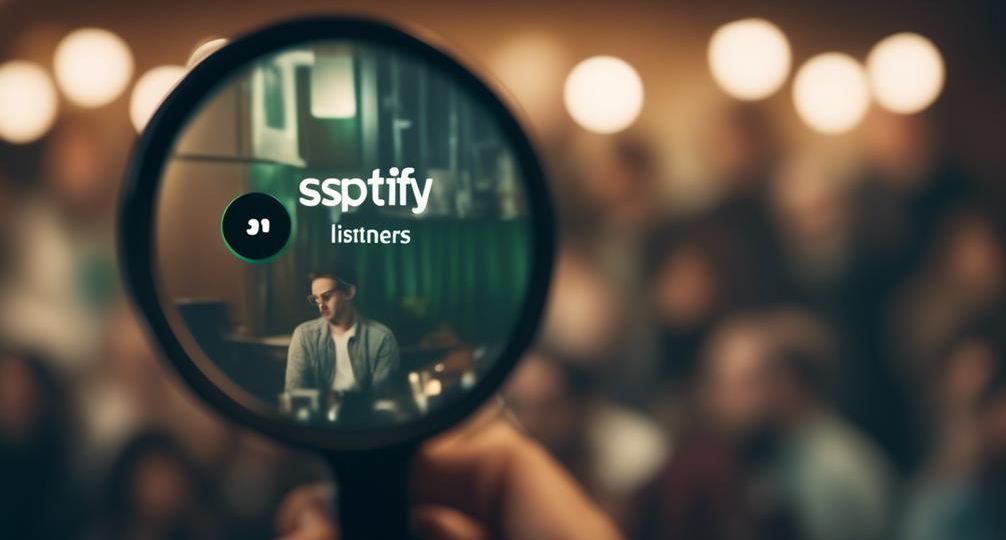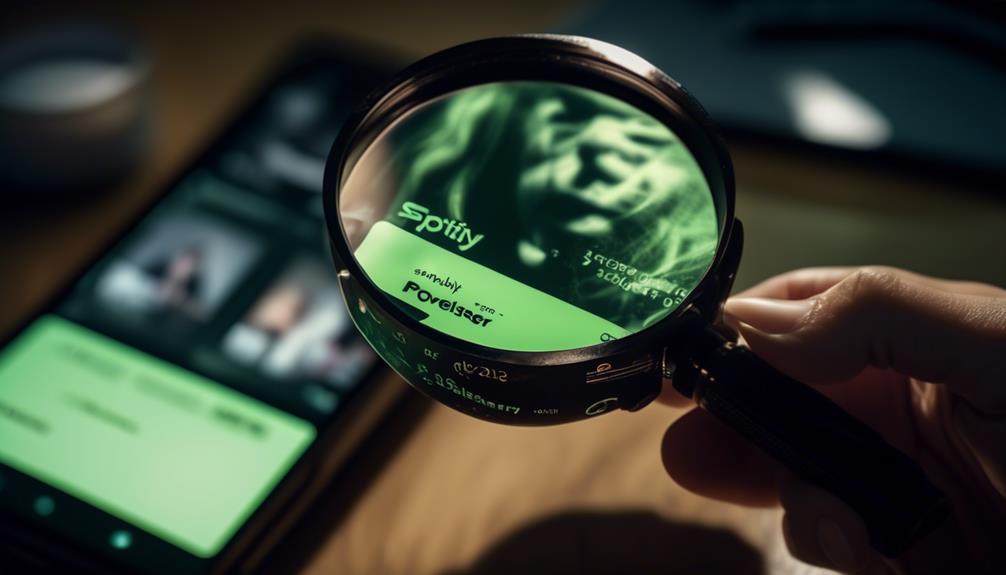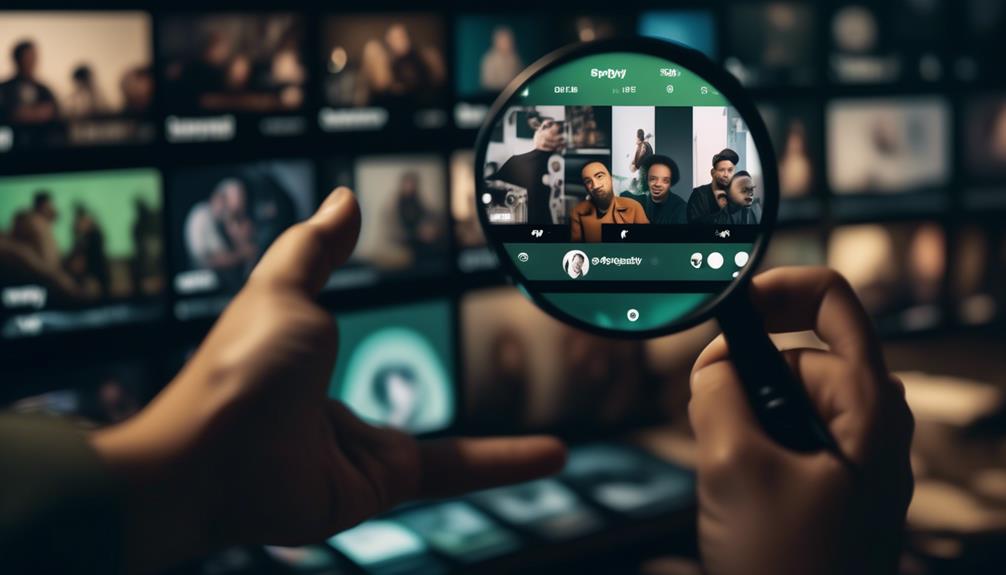
Can Spotify artists see who their monthly listeners are?
Imagine you’re a musician with a growing fanbase on Spotify. You’ve noticed your monthly listeners increasing, which is fantastic, but it’s left you wondering: Can you actually see who these listeners are?
It’s a question that many artists grapple with, as understanding your audience can be a key component in strategizing your music career.
Before we embark on this exploration, it’s important to take into account the privacy policies that govern user data and the analytics provided by Spotify.
So, are you ready to unravel this mystery and potentially discover a whole new perspective on your listener base?
Key Takeaways
- Spotify’s artist analytics provide valuable insights into an artist’s reach and popularity.
- Monthly listeners on Spotify quantify the unique listeners who play an artist’s music in a 30-day period and fluctuate based on listener demographics and streaming patterns.
- Monthly listeners serve as a powerful tool for artists to understand their audience and tailor their music, leading to more streams and revenue generation.
- While Spotify provides data on listener demographics, artists cannot see the specific identities of their monthly listeners, maintaining user anonymity and privacy.
Understanding Spotify’s Artist Analytics

To fully grasp Spotify’s artist analytics, you need to delve into the platform’s unique metrics, such as monthly listeners and stream counts, which give invaluable insight into an artist’s reach and popularity. These metrics aren’t just numbers; they’re dynamic indicators of an artist’s influence and potential for streaming revenue.
As an artist, you’ve got to understand that every stream contributes to your overall earnings on Spotify. Even if you’re just starting out, don’t underestimate the power of a single stream. It’s a building block towards your streaming revenue and, ultimately, your success in the music industry.
Artist promotion on Spotify is another critical aspect that complements its analytics. You can’t just rely on your music to speak for itself. You’ve got to be proactive in promoting your tracks, and Spotify’s analytics can guide your promotional efforts. By analyzing your top-performing tracks, you’ll know what resonates with your audience and can create more of the content they love.
The Concept of Monthly Listeners
You’re now ready to grasp the concept of monthly listeners on Spotify, a factor that significantly impacts artists’ reach and popularity on the platform.
As we explore this, we’ll also touch on the potential privacy concerns tied to this feature.
This understanding will provide a new lens through which to view both the artist and listener experience on Spotify.
Understanding Monthly Listeners
In the realm of Spotify, ‘Monthly Listeners’ is a key metric that provides invaluable insights into an artist’s popularity and reach, by quantifying the unique listeners who play their music during a 30-day period. This number isn’t static; it fluctuates based on listener demographics and streaming patterns.
Here’s a brief overview:
| Metric | Description | Importance |
|---|---|---|
| Monthly Listeners | Unique listeners in 30 days | Measures reach |
| Listener Demographics | Age, location, gender | Helps target audience |
| Streaming Patterns | Frequency, time, song preference | Reveals engagement |
Understanding these aspects, you can better appreciate the impact of monthly listeners on an artist’s success. It’s not just about how many people are listening, but who they are and how they’re engaging with the music.
Impact on Spotify Artists
For Spotify artists, the metrics of monthly listeners can serve as a powerful tool in understanding their audience and tailoring their music to enhance engagement and growth. These numbers shed light on your reach and influence, helping you identify trends and track progress over time.
Higher monthly listeners equate to more streams, and consequently, more revenue generation.
Moreover, this data shapes your artist promotion strategies. You can target your promotional efforts to the demographic that resonates most with your music, maximizing your impact. It’s not just about gaining more listeners, but cultivating a loyal fanbase that will sustain your music career.
Thus, monthly listener metrics aren’t just numbers; they’re vital insights propelling your journey on Spotify.
Privacy Concerns Explored
While the concept of monthly listeners offers valuable insights, it’s worth exploring the privacy concerns that might arise from such data collection. Data security is a paramount concern in this era of digital innovation. Spotify, like many tech companies, must balance user anonymity with the provision of data to artists.
The ‘monthly listeners’ metric provides artists with a numerical value of their audience, but it doesn’t reveal specific user identities or their listening habits. This approach maintains a level of user anonymity, ensuring listeners’ privacy is respected while still offering artists vital insights.
It’s a delicate equilibrium, reflecting the need for both meaningful data analytics and robust privacy protections. As technology evolves, the challenge to maintain this balance will only intensify.
Spotify’s Privacy Policy and User Data
You must consider how Spotify’s privacy policy impacts both artists and listeners.
The platform’s data collection practices can offer valuable insight into listener preferences, which can significantly influence an artist’s approach.
It’s essential to comprehend the implications of these practices, as they shape the landscape of music streaming services.
Understanding Spotify’s Privacy Policy
Diving into Spotify’s privacy policy, it’s crucial to understand how the platform handles user data, and the implications it has on your listening experience.
Spotify’s data protection measures are designed to safeguard your information. They collect, process, and utilize your data based on the user consent process, which you agree to upon creating an account.
This data includes what you listen to, your interactions, and your location, which all help to curate a personalized experience.
However, it’s important to note that your data isn’t shared with artists in a way that identifies you personally, ensuring your privacy. Therefore, while artists get insights on their audience, they can’t see exactly who’s listening.
User Data Collection Practices
So, how exactly does Spotify’s privacy policy affect its user data collection practices? Well, Spotify’s data security measures are robust, collecting user data to enhance user experience and cater to ad-targeted algorithms. The data collected includes your music preferences, listening habits, playlists, and interaction with other users.
Here’s a brief look at Spotify’s data collection practices:
| User Data Collected | Purpose |
|---|---|
| Music preferences | Personalize user experience |
| Listening habits | Improve recommendations |
| Playlists created | Tailor ad-targeted algorithms |
| Interaction with users | Enhance social features |
Any changes in their policy are promptly communicated to ensure you’re always aware of the data you’re sharing. Spotify’s innovative approach to data collection and use is designed to create a personalized, immersive music experience.
Implications for Spotify Artists
When considering Spotify’s privacy policy and data collection practices, it’s crucial to understand the implications these have for artists on the platform.
The inability to access detailed listener data restricts your scope for targeted artist promotion. While Spotify’s policies safeguard user privacy, they also limit your potential for revenue generation.
Analyzing user data could enable you to tailor your music to your audience’s preferences, optimize your marketing strategies, and maximize income.
So, while Spotify’s privacy stance is commendable, it’s essential to balance it with artists’ needs. Innovative solutions, like anonymized listener profiles or aggregated data, could provide the insights you need without compromising user privacy.
This is the challenge and opportunity facing artists and Spotify alike.
What Information Spotify Provides Artists
Spotify provides a wealth of data to artists, including insights into their monthly listeners, to help them understand their audience better. As an artist, you can access this data through the Artist Dashboard Features. This dashboard offers a detailed breakdown of your listeners, showing you where they’re located, their age, gender, and even what other artists they listen to.
A few key data points you can take advantage of are:
- Your total number of streams and listeners
- Real-time statistics on new releases
- Playlist inclusions and the performance of your tracks on these playlists
With this information, you can tailor your music and marketing strategies to your audience. The Playlist Inclusions feature, for instance, shows you the playlists your songs are on, and how they’re performing. This insight can guide you on what songs to promote and where.
Spotify’s robust data offerings are more than just numbers. They’re tools for you to gauge and engage with your listeners, craft strategies that resonate with your audience, and ultimately, drive your music career forward.
Stay ahead of the curve by leveraging these insights and turning them into innovative strategies.
Interpreting Listener Data on Spotify

Understanding and interpreting your listener data on Spotify can significantly enhance your music promotion strategy, as it provides valuable insights into your audience’s preferences and behavior. Data interpretation is a vital tool in the modern music industry, enabling you to tailor your approach to engage your listeners more effectively.
The data Spotify provides includes your listeners’ demographics, such as their age, gender, and location. This information allows you to understand who your audience is and where they’re coming from. It’s a goldmine for crafting targeted marketing strategies. If you see your music resonating more with a certain demographic, you can focus your advertising efforts there.
Another crucial metric is the playlists featuring your tracks. It shows where your music is being discovered, which can inform your promotional efforts. If a track is popular on a specific playlist, you can leverage that to gain more exposure.
However, it’s not just about the numbers. The ‘why’ behind the data is equally important. Why do certain songs resonate more? Why are some regions more engaged? Answering these questions can help refine your strategy, creating a more personalized experience for your audience.
Enhancing Artist-Listener Connection
Building on this foundation of data analysis, you can truly enhance your connection with your listeners, creating a stronger bond that transcends the music itself. Innovative tools like Spotify’s data analytics can assist in boosting your listener engagement and artist branding. With this in mind, consider the following strategies:
- Utilize your data to understand your audience’s preferences and habits. This understanding can guide the creation of content that resonates deeply with them, ultimately strengthening your bond.
- Engage directly with your listeners through digital platforms. Personalized responses and interactions can foster a sense of connection that goes beyond the music, building a robust community around your brand.
- Tailor your branding strategy based on your audience demographics and interests. This creates a sense of authenticity that listeners appreciate and gravitate towards.
These steps, grounded in data analysis, put you on a path towards a more personal and powerful relationship with your listeners.
In this digital age, using these resources effectively is a game-changer, enabling artists to connect with their audiences on a deeper level, enhancing their brand and ensuring their music continues to resonate.
Spotify Insights: Case Studies and Examples

Let’s dive into concrete examples and case studies that illustrate the transformative power of Spotify’s insights for artists.
Consider the case of an emerging indie rock band. By using Spotify’s data-driven marketing tools, they were able to pinpoint their core audience, segment them based on listening habits, and tailor their promotional efforts accordingly.
This band discovered their music was being streamed heavily in specific regions. By leveraging this information, they planned a targeted tour in those areas, resulting in sold-out shows and an exponential growth in fanbase. It’s an excellent example of how Spotify insights can lead to strategic decision-making, boosting an artist’s career trajectory.
Similarly, a pop artist used Spotify’s insights to understand the demographic details of her listeners, identifying a strong following among females aged 18-24. She then collaborated with brands popular with this demographic for powerful cross-promotion, thus leveraging audience segmentation for maximum impact.
These examples underscore how artists can harvest the power of Spotify’s insights to understand their listeners better, shape their marketing strategy, and ultimately, amplify their success.
The key is to understand and utilize these data points innovatively and strategically, driving a more meaningful and tailored connection with listeners.

